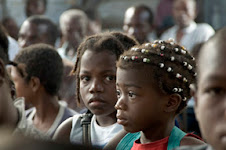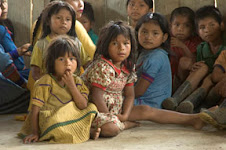 I’ve mostly been reporting on curiosities or other aspects of Bogotá that I enjoy. I hope you all enjoy the reports as well. But recently I got to spend most of the day looking at another face of this area. I wasn’t actually in Bogotá, but in the neighboring municipio of Soacha. (It’s hard to describe what a municipio is, exactly; we often translate it as “municipality,” but that hardly conveys its meaning. For people from the US, it more or less corresponds to a county, in the sense that it’s the next level of political subdivision down from a department, as a county is to a state for us, and like a county, may include cities, towns and other units. But a municipio has more authority and is a more active than a county.)
I’ve mostly been reporting on curiosities or other aspects of Bogotá that I enjoy. I hope you all enjoy the reports as well. But recently I got to spend most of the day looking at another face of this area. I wasn’t actually in Bogotá, but in the neighboring municipio of Soacha. (It’s hard to describe what a municipio is, exactly; we often translate it as “municipality,” but that hardly conveys its meaning. For people from the US, it more or less corresponds to a county, in the sense that it’s the next level of political subdivision down from a department, as a county is to a state for us, and like a county, may include cities, towns and other units. But a municipio has more authority and is a more active than a county.)Soacha is big—it covers a lot of ground and has a substantial population. There are sectors and barrios that have been around for quite a while, and it is a center for some industrial activities, among them producing construction materials and recycling. In recent years, the population has grown as many people displaced by the violence have settled there (as well as in Bogotá proper). Many of the displaced live in truly distressing conditions in very poor sectors of Soacha, and have serious problems in getting by.
 So I was very pleased to be invited by Catholic Relief Services to accompany some workers from the Pastoral Social in the delivery of food to some of these needy families, and to have my first introduction to the area.
So I was very pleased to be invited by Catholic Relief Services to accompany some workers from the Pastoral Social in the delivery of food to some of these needy families, and to have my first introduction to the area.The food was delivered through a program called Programa Alimentario Nacional de Emergencias (PANEM) (its first initials, PAN, form the word for bread in Spanish), a joint program of the National Secretariat of Pastoral Social of the Catholic church in Colombia, CRS, the UN’s World Food Program, and the nine diocese where the program is being carried out. I was able to attend a meeting of the beneficiaries, and observe the distribution of basic foodstuffs—rice, lentils, cooking oil. I also was able to talk with a young mother from El Chocó and visit the house she shares with three of her six children.
(A few days later, along with other Fulbright fellows, I had a look at another district that houses large numbers of low-income people, and numerous families displaced by the violence, Bosa. Bosa is one of the 20 districts or minor cities within Bogotá proper, but in appearance was quite similar to Soacha, though smaller. Here, too numbers of people work in recycling, collecting or preparing materials for the big processors. It’s hard, dirty and ill-paid work.)
Soacha has several pretty clearly-defined districts. Along with the Pastoral Social workers, I visited three: Oasis, La Capilla and Balcanes, as well as walking and riding a little buseta through a couple of others.
 Many of the people of Soacha, especially but not exclusively the displaced, live in very precarious situations. They have little or no regular income, and try to eke out of living in the “rebusuqe,” searching for work in the informal sector. The woman I met from El Chocó makes a small amount of money washing and ironing clothes. The houses of people in this situation are quite miserable, and are often built on unstable land, or are subject to floods or landslides. Fundamental human and social services are spotty at best. The organizations that serve the people of the area are concerned to avoid creating a dependency relationship, but under the current economic and social conditions it’s hard to avoid.
Many of the people of Soacha, especially but not exclusively the displaced, live in very precarious situations. They have little or no regular income, and try to eke out of living in the “rebusuqe,” searching for work in the informal sector. The woman I met from El Chocó makes a small amount of money washing and ironing clothes. The houses of people in this situation are quite miserable, and are often built on unstable land, or are subject to floods or landslides. Fundamental human and social services are spotty at best. The organizations that serve the people of the area are concerned to avoid creating a dependency relationship, but under the current economic and social conditions it’s hard to avoid.Although this visit was only the initial very small step in what we hope will later be a photographic project in some of the comities served by PANEM, it was an important reminder for me of the importance of keeping in mind this side of the reality of Bogotá and the surrounding area. In the near future, I expect to post a good number of pictures of Soacha at my pbase website. For the moment, I hope the ones here can help you visualize the situation.

Otra Cara de Bogotá:
Generalmente, he venido contando sobre curiosidades u otros aspectos de Bogotá que me caen bien. Espero que Uds. también gocen de ellos. Pero hace muy poco tuve la posibilidad de pasar mayor parte del día mirando otra cara de este área. De hecho, no estuve en Bogotá, sino en el municipio vecino de Soacha. (Cuesta trabajo describir a norteamericanos que cosa es un municipio precisamente; muchas veces lo traducimos
 como “municipality,” pero eso apenas lleva su significado. Por estadounidenses, más o menos corresponde a un condado, en el sentido que es la próxima estructura debajo de un departamento, tal como un condado es dentro de un estado para nosotros, y como condado, puede abarcar a ciudades, pueblos y otras unidades. Pero un municipio tiene más autoridad y es más activo que un condado.)
como “municipality,” pero eso apenas lleva su significado. Por estadounidenses, más o menos corresponde a un condado, en el sentido que es la próxima estructura debajo de un departamento, tal como un condado es dentro de un estado para nosotros, y como condado, puede abarcar a ciudades, pueblos y otras unidades. Pero un municipio tiene más autoridad y es más activo que un condado.)Soacha es grande—tiene gran extensión y población considerable. Hay sectores y barrios que llevan muchos años, y es un centro de unas actividades industriales, entre ellas elaboración de materiales para construcción y reciclaje. En los últimos años, la población ha crecido con el asentar allá de mucha gente desplazada por la violencia (además de dentro de Bogotá). Mucha de la gente desplazada vive en condiciones verdaderamente lamentables, y encuentran problemas económicos graves.
Pues quedé complacido cuando me invitó Catholic Relief Services a que acompañara a unos trabajadores de la Pastoral Social en una entrega de alimentos a algunas familias necesitadas, y a tener mi primer presentación del área.
Los alimentos fueron entregados a través de un proyecto llamado Programa Alimentario Nacional de Emergencias (PANEM), un programa conjunto del Secretariado Nacional de Pastoral Social de la iglesia católica, CRS, el Programa Mundial de Alimentación de
 la ONU, y las nueve diócesis donde se lleva a cabo el programa. Tuve la oportunidad de asistir a una reunión de los beneficiados, y de observar la entrega de alimentos básicos—arroz, lentejas, aceite. También tuve la posibilidad de hablar con una madre joven chocoana, y visitar la casa donde vive con tres de sus seis niños/as.
la ONU, y las nueve diócesis donde se lleva a cabo el programa. Tuve la oportunidad de asistir a una reunión de los beneficiados, y de observar la entrega de alimentos básicos—arroz, lentejas, aceite. También tuve la posibilidad de hablar con una madre joven chocoana, y visitar la casa donde vive con tres de sus seis niños/as.(Unos días después, junto con otros becarios Fulbright, eché un vistazo a otro distrito en que habitan cantidades grandes de gente de bajos ingresos y muchas familias desplazadas por la violencia, Bosa. Bosa es uno de los 20 distritos o alcaldías menores dentro de Bogotá, pero se parecías mucho con Soacha, aunque es más pequeño. Acá también cantidad de gente se dedica a reciclaje, recogiendo o preparando materiales para los procesadores grandes. Es trabajo duro, sucio y mal pagado.)
Soacha cuenta con varios distritos, claramente definidos. Junto con los trabajadores de la pastoral Social, visité tres: Oasis, La Capilla y Balcanes, además atravesar unos más a pie o una buseta.
Mucha de la gente de Soacha, especialmente pero no únicamente los desplazados, vive en condiciones muy precarias. No tienen, o tiene muy bajos, ingresos fijos, y tratan de ganar un poco en el “rebusque,” buscando trabajo en el sector informal. La señora chocoana que conocí gana un poco lavando y planchando. Las casas de le gente en esta situación muchas veces son miserables, y se construyen en tierras inestables,

o donde hay inundaciones o derrumbes. Servicios humanos y sociales fundamentales, cuando existen, no son adecuados. La organizaciones que atienden a la gente se preocupan por no crear relaciones asistencialistas, pero bajo las condiciones económicas y sociales actuales, es difícil evitar.
Aunque esta visita fue nada más un pasito muy pequeño en lo que esperamos sea más tarde un proyecto fotográfico en algunos de las comunidades servidos por el PANEM, fue para mi un recordatorio importante de la necesidad de tener presente esta cara de la realidad de Bogotá y sus alrededores. En una futura próxima, espero entrar una cantidad de fotos de Soacha a mis páginas de pbase. Por el momento, espero que las que he puesto acá les ayuden a visualizar la situación.


No comments:
Post a Comment